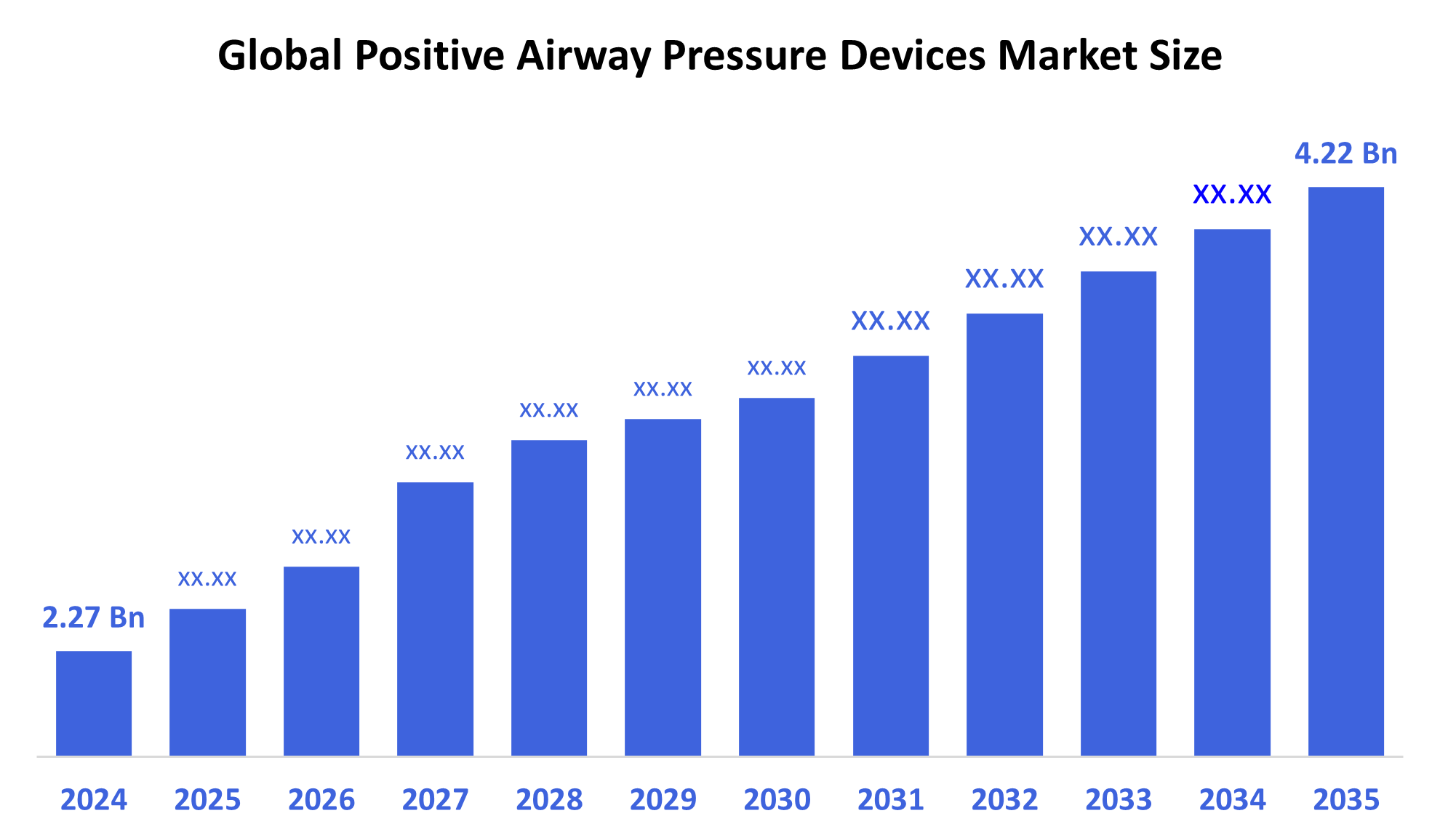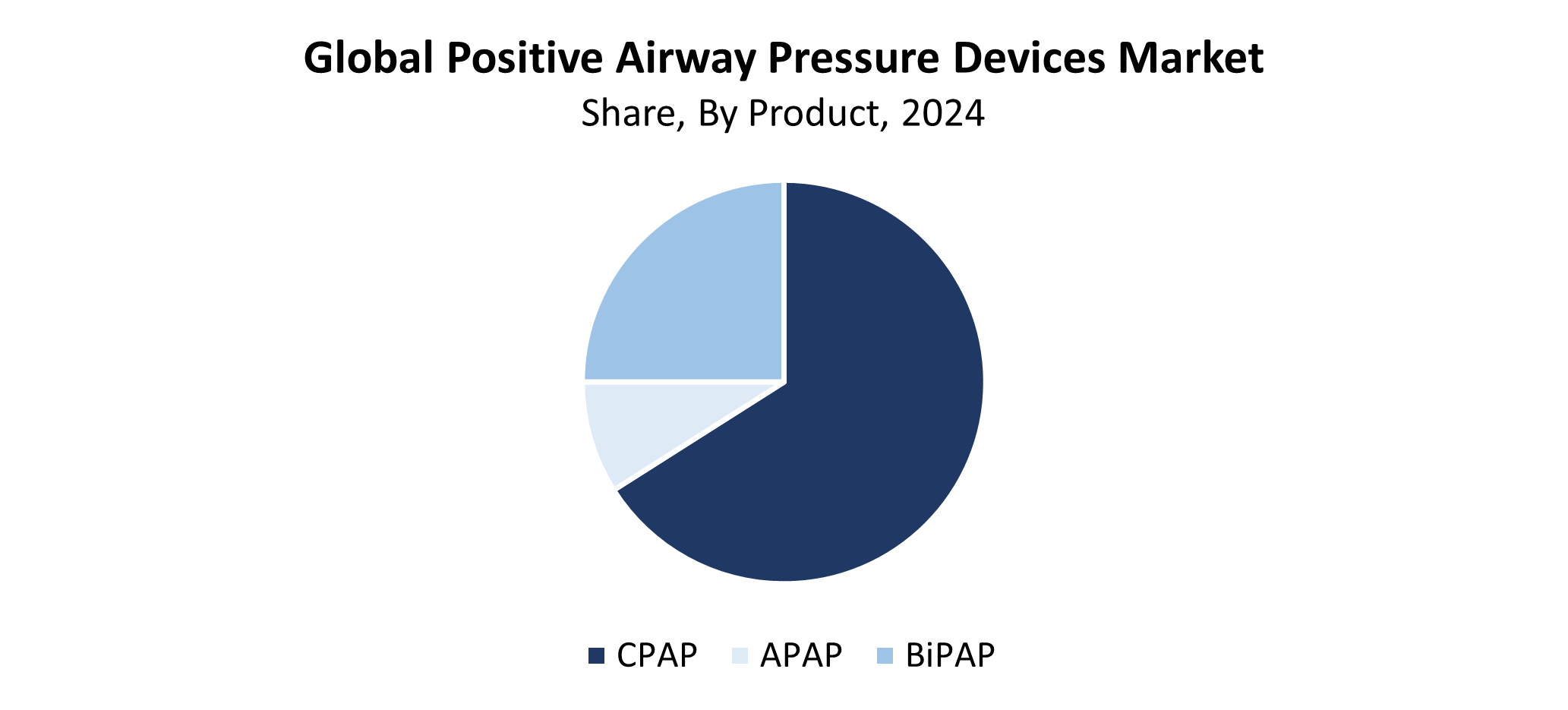Global Positive Airway Pressure Devices Market
Global Positive Airway Pressure Devices Market Size, Share, and COVID-19 Impact Analysis, By Product (CPAP, APAP, BiPAP), By End Use (Home Care Settings, Hospitals & Clinics, Others), and By Region (North America, Europe, Asia-Pacific, Latin America, Middle East, and Africa), Analysis and Forecast 2025-2035.
Report Overview
Table of Contents
Positive Airway Pressure Devices Market Summary
The Global Positive Airway Pressure Devices Market Size Was Estimated at USD 2.27 Billion in 2024 and is Projected to Reach USD 4.22 Billion by 2035, Growing at a CAGR of 5.8% from 2025 to 2035. The market for positive airway pressure devices is growing as a result of rising obesity rates, sleep apnea prevalence, increased awareness of respiratory conditions, technical improvements, and the expansion of healthcare infrastructure worldwide.

Key Regional and Segment-Wise Insights
- In 2024, North America held the largest revenue share of over 45.4% and dominated the market globally.
- In 2024, the CPAP segment had the highest market share by product, accounting for 66.46%.
- In 2024, the hospitals and clinics segment had the biggest market share by end use.
Global Market Forecast and Revenue Outlook
- 2024 Market Size: USD 2.27 Billion
- 2035 Projected Market Size: USD 4.22 Billion
- CAGR (2025-2035): 5.8%
- North America: Largest market in 2024
The positive airway pressure (PAP) devices market includes medical equipment designed to address sleep-related breathing disorders, especially obstructive sleep apnea (OSA). These devices deliver either fixed or variable air pressure to keep your airways open during sleep, which boosts breathing efficiency and overall sleep quality. The market expands because sleep apnea cases increase due to worldwide population aging, combined with higher obesity statistics and inactive lifestyles. Growing awareness of sleep apnea dangers, along with its cardiovascular consequences and fatigue symptoms, has led to increased diagnosis and treatment initiatives. The demand grows stronger because of modern PAP device availability, together with expanding healthcare facilities and increasing disposable income across developing economies.
Modern technology has transformed the way PAP devices function while enhancing the comfort patients experience during treatment. Wireless connectivity for remote monitoring, together with integrated humidifiers and auto-titrating PAP machines, leads to improved treatment adherence and better results. Intelligent technologies, together with user-friendly interfaces, enable more personalized therapy for patients. Government campaigns and healthcare activities promoting sleep health awareness and reimbursement programs in industrialized nations drive the expanding market for PAP devices. The worldwide adoption of PAP devices continues to grow because public health initiatives receive more funding and researchers conduct studies on respiratory disorders.
Product Insights

The continuous positive airway pressure (CPAP) devices segment led the positive airway pressure devices market in 2024 with the largest revenue share of 66.46%. CPAP devices remain the leading treatment for obstructive sleep apnea (OSA) because they demonstrate proven effectiveness in maintaining airway patency during sleep. The widespread adoption of these devices stems from three major reasons: rising obstructive sleep apnea rates worldwide, improved diagnostic methods, and increased sleep disorder understanding. CPAP machines function as primary therapeutic devices because patients usually obtain them at more affordable costs compared to other PAP device options. Technological progress in CPAP equipment, including reduced noise production and compact designs along with built-in humidifiers and connectivity solutions, has enhanced user comfort and increased market share for CPAP devices.
The bi-level positive airway pressure (BiPAP) devices segment of the positive airway pressure devices market is anticipated to grow at the fastest CAGR throughout the forecast period. The increasing number of patients with moderate to severe obstructive sleep apnea and other respiratory conditions, such as congestive heart failure and chronic obstructive pulmonary disease (COPD), that require BiPAP pressure support drives this growth. Patients benefit from BiPAP devices through their dual pressure settings, which enhance comfort while serving individuals with combined medical conditions and needing higher pressure levels. The quick adoption of this technology will result from enhanced pressure algorithms alongside intuitive user interfaces and growing awareness about complex sleep disorders.
End Use Insights
The hospitals and clinics segment held the largest revenue share and led the positive airway pressure (PAP) devices market in 2024. The extensive volume of sleep apnea diagnosis and treatment conducted in these healthcare facilities explains their market dominance. Hospitals and clinics serve as primary locations for conducting sleep studies and initiating PAP treatment because they function as the first medical contact for people who show signs of obstructive sleep apnea (OSA) or respiratory conditions. A wide range of PAP devices alongside advanced diagnostic equipment and expert medical staff enable precise diagnosis and personalized treatment plans. The leading market position of this segment has grown stronger due to increasing sleep disorder cases along with rising awareness about early treatment methods.
During the forecast period, the positive airway pressure (PAP) devices market’s home care settings segment is projected to grow at a significant rate. The rising preference of patients for home-based therapy stems from its convenience, along with comfort and cost-effectiveness, which propels this market expansion. Advancements in compact and easy-to-use PAP devices have made home therapy more available to patients, which helps them stick with their treatment. The increasing adoption of remote patient monitoring, together with telemedicine services alongside rising sleep apnea awareness, drives this segment's expansion. The COVID-19 pandemic accelerated home care adoption by promoting remote management of chronic conditions, which decreased hospital visit requirements. Healthcare infrastructure development, together with supportive payment methods across various regions, leads to higher utilization of PAP devices in home care settings.
Regional Insights
The global market for positive airway pressure (PAP) devices is dominated by the North America region, accounting for the largest revenue share of 45.4% in 2024. The leading position of this market stems from the combination of high respiratory condition rates and governmental programs that focus on early diagnosis, together with public educational campaigns. Robust government respiratory health programs, together with established reimbursement rules and strong healthcare infrastructure, enable widespread PAP device usage throughout the country. Major market participants who dedicate substantial resources to research and development, along with technological innovation, help North America maintain its market position. Advanced medical facilities, along with growing patient interest in effective sleep apnea solutions, push North America to lead the PAP device market.
Asia Pacific Positive Airway Pressure Devices Market Trends
The Asia Pacific market for positive airway pressure (PAP) devices experiences significant growth due to increased understanding of sleep disorders and the escalating occurrence of obstructive sleep apnea (OSA). The rising numbers of respiratory health issues stem primarily from three main contributors: urban development, lifestyle transformations, and populational weight gain. Healthcare infrastructure development, together with enhanced medical facility accessibility and rising disposable income in China, India, and Japan, fuels market growth. The rising acceptance of respiratory health initiatives alongside increased medical coverage for sleep disorder diagnosis and treatment drives market growth. The availability of affordable PAP devices and technological progress in therapy delivery enables patients to access treatment more easily. The expanding telemedicine network, along with growing home care services across the region, drives this market's accelerated growth.
Europe Positive Airway Pressure Devices Market Trends
Throughout the forecast period, the positive airway pressure (PAP) device market in Europe is expected to grow at a significant CAGR because respiratory illnesses and sleep apnea cases continue to increase within the region. Multiple European countries, including Germany, the UK, and France, are raising their awareness about early diagnosis together with effective treatment of obstructive sleep apnea (OSA). The broad adoption of PAP devices benefits from supportive reimbursement systems along with an established healthcare network. Technological progress in portable connected easy-to-use PAP devices enhances treatment outcomes and patient adherence. The increased use of these devices receives support from both governmental initiatives and health campaigns, which work to reduce respiratory disease conditions. The growing population of elderly individuals, combined with increasing obesity statistics, drives European demand for positive airway pressure treatments.
Key Positive Airway Pressure Devices Companies:
The following are the leading companies in the Positive Airway Pressure Devices Market. These companies collectively hold the largest market share and dictate industry trends.
- Koninklijke Philips N.V.
- Wellell (Apex Medical)
- Fisher & Paykel Healthcare Limited
- SEFAM
- Löwenstein Medical UK Ltd
- Armstrong Medical Inc.
- React Health (3B Medical)
- Transcend Inc. (Somnetics International, Inc.)
- Drive DeVilbiss Healthcare
- BMC Medical
- Trudell Medical (Vyaire)
- ResMed
- Breas Medical
- Others
Recent Developments
- In June 2024, the IntelliPAP function was added to React Health's V+Pro, V*Home, V+C, and VC+Pro ventilators. React Health is a manufacturer and distributor of sleep and respiratory products. When sleep-disordered breathing events are identified, this function allows doctors to automatically modify PEEP levels during noninvasive ventilation for patients with OSA and respiratory insufficiency.
- In February 2024, ResMed unveiled the AirCurve 11 line of bilevel devices, which support both expiratory and inspiratory pressure. These gadgets combine digital technology, making it easier for medical professionals to treat sleep apnea while also assisting patients in starting and continuing successful treatment.
Market Segment
This study forecasts revenue at global, regional, and country levels from 2020 to 2035. Spherical Insights has segmented the positive airway pressure devices market based on the below-mentioned segments:
Global Positive Airway Pressure Devices Market, By Product
- CPAP
- APAP
- BiPAP
Global Positive Airway Pressure Devices Market, By End Use
- Home Care Settings
- Hospitals & Clinics
- Others
Global Positive Airway Pressure Devices Market, By Regional Analysis
- North America
- US
- Canada
- Mexico
- Europe
- Germany
- UK
- France
- Italy
- Spain
- Russia
- Rest of Europe
- Asia Pacific
- China
- Japan
- India
- South Korea
- Australia
- Rest of Asia Pacific
- South America
- Brazil
- Argentina
- Rest of South America
- Middle East & Africa
- UAE
- Saudi Arabia
- Qatar
- South Africa
- Rest of the Middle East & Africa
Check Licence
Choose the plan that fits you best: Single User, Multi-User, or Enterprise solutions tailored for your needs.
We Have You Covered
- 24/7 Analyst Support
- Clients Across the Globe
- Tailored Insights
- Technology Tracking
- Competitive Intelligence
- Custom Research
- Syndicated Market Studies
- Market Overview
- Market Segmentation
- Growth Drivers
- Market Opportunities
- Regulatory Insights
- Innovation & Sustainability
Report Details
| Pages | 240 |
| Delivery | PDF & Excel via Email |
| Language | English |
| Release | Sep 2025 |
| Access | Download from this page |
